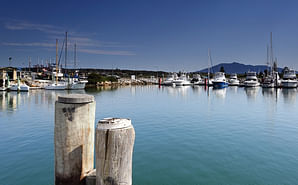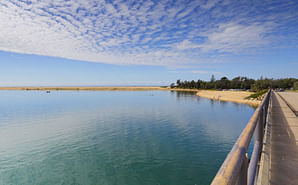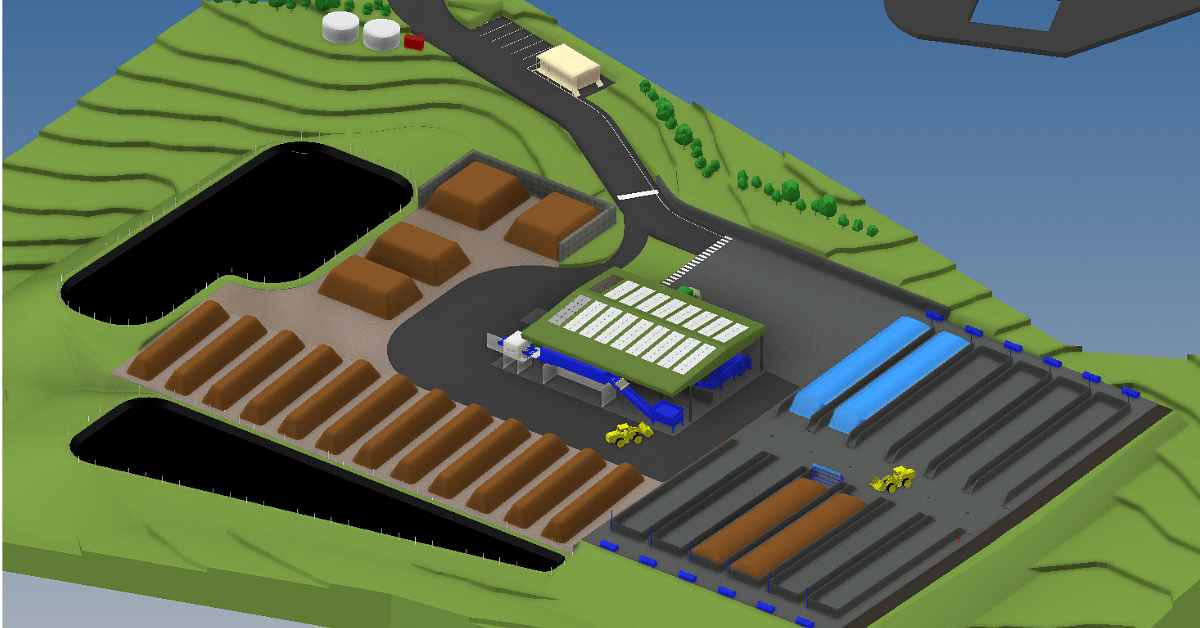Organics Processing Facility Environmental Impact Statement
An update on the new Organics Processing Facility (OPF) at the Central Waste Facility (CWF), and progress on the Environmental Impact Statement (EIS) for the OPF.
A draft render of the proposed new Organics Processing Facility
Project Summary/background
Organics Processing Facility
Bega Valley Shire Council is planning a new Organics Processing Facility (OPF) at the Central Waste Facility (CWF) in Wolumla. SOILCO were selected through a competitive procurement process and will be constructing and operating the facility, comprised of a covered receival and processing building, covered composting bays, maturation & storage areas, and leachate management system.
The OPF will initially utilise a covered aerated static pile (or CASP) process to compost up to 15,000 tonnes per annum of FOGO (Food Organics and Garden Organics) with approvals for a planned expansion of up to 30,000 tonnes per annum in the future. It will utilise fully electrical processing equipment which will be powered by rooftop solar.
An Environmental Impact Statement (EIS) is being prepared for the OPF. This is a requirement to ensure that all environmental, social and economic impacts associated with the facility are reviewed, considered, and appropriately managed during construction and operations. Some of the impacts reviewed include noise, air quality and odour, surrounding land uses, bushfire risks, and traffic impacts.
These studies are conducted by independent specialists and are reviewed and approved by the NSW Environmental Protection Agency and Regional Planning Panel before works can begin. The EIS, which includes the detailed results of all independent studies, will be made available upon finalisation and during public exhibition.
The OPF is part of Council’s ongoing improvements and upgrades at the CWF which are outlined within the site’s Masterplan.
Bega Central Waste Facility (CWF) Masterplan
The CWF Masterplan sets the long-term direction for the activities, infrastructure and services provided at the CWF. The draft Masterplan has identified a number of opportunities that can improve the CWF and ensure the site is sustainable in the longer term.
These opportunities include expanding the landfill towards the north of the site to provide long-term capacity and security for the community’s waste disposal needs. Extensive geotechnical and hydrogeological investigations have been undertaken to ensure that any future landfilling prevents or minimises environmental and social impacts.
As with the OPF, an EIS is being prepared to expand landfill operations, ensuring that the potential impacts of the planned activities and future upgrades are minimised and managed appropriately. The EIS, which includes the detailed results of all independent studies, will be made available upon finalisation and during public exhibition.
Additional opportunities that the CWF Masterplan identifies include a new office building and education centre which will improve Council’s waste education programs, promote resource recovery and help reduce waste going to landfill. The Masterplan also proposes additional vegetation plantings for visual screening, biodiversity protection measures and erosion management controls.
It is envisaged that the CWF will become a centralised hub for resource recovery and contribute to the circular economy by facilitating stockpiling, sorting, and processing of a variety of materials including construction and demolition (C&D) inert waste, steel and commingled recyclables. Longer term, the CWF has identified areas for circular economy activities such as microfactories that can manufacture new products from what was typically waste materials.
Lastly, the access roads, weighbridge, security system and fencing require upgrades to ensure safety, efficiency and longevity.
An Environmental Impact Statement (EIS) is a required legislative process to ensure that all environmental, social and economic impacts associated with the OPF are identified, avoided, minimised or mitigated throughout all stages of the development and operation. This EIS has been prepared in accordance with the Planning Secretary’s Environmental Assessment Requirements 1669 that were issued on the 23rd of May 2022.
The following impact assessments and plans are being prepared as part of the EIS for the OPF:
- Air Quality and Odour
- Heritage assessment
- Visual Impact
- Traffic Impact
- Noise and Vibration
- Biodiversity
- Bushfire Risk
- Weed Management
- Land Use Conflict Risk
- Floodplain Impacts
- Surface Water Management
- Leachate Management
These reports are then collated and reviewed to form a completed EIS which is submitted as part of the development application to an independent local planning panel and the NSW EPA before development approval can be granted and works begin.
An Air Quality and Odour Impact Assessment using an air dispersion model has been undertaken by The Odour Unit to determine the effectiveness of planned odour management controls at the OPF and to identify any additional mitigation measures.
It will be available publicly upon finalisation of the EIS.
An Aboriginal Cultural Heritage Assessment Report and European Heritage Impact Assessment have being undertaken by heritage consultants, Archaeological Management and Consulting Group, as part of the EIS process to survey the potential impacts on heritage on site and surrounding areas. This includes assessment of Aboriginal artefacts, European heritage, including built and environmental aspects.
Aboriginal artefacts are referred to the NSW Aboriginal Land Council for review, while European heritage aspects and items are assessed on their condition and value. Where required, conservation management plans would also be created for future preservation management.
The full reports will be made available upon finalisation of the EIS.
Green Bean Design Landscape Architecture has undertaken an assessment of the visual character of the site and the surrounding landscape in order to determine the extent and nature of any potential visual changes from the OPF development. Where appropriate, measures to mitigate and minimise any significant visual impacts have been proposed.
The report will be publicly available upon finalisation of the EIS.
Traffix Pty Ltd have conducted a Traffic and Access Assessment at the OPF site in order to gain an understanding of the existing traffic conditions and access available to and from the surrounding road network. Publicly available road safety data at the intersection of Princes Highway and Wanatta Lane was examined, along with plans detailing site access arrangements, internal traffic circulation arrangements and parking layouts for residential and commercial vehicles. A capacity assessment of the intersection of Princes Highway and Wanatta Lane was also undertaken.
The full traffic impact assessment report will be made available in the finalised EIS.
As part of the EIS, a Biodiversity Threshold Assessment, Weed Management Plan, and Bushfire Risk Assessment have being developed.
These assessments, prepared by expert consultants, analyse the current ecological state of the site, as well as what level of impact the proposed development will have on the surrounds. They will also propose ongoing management requirements, and details of any Biodiversity Offsets if required.
The Biodiversity Development Assessment Report was prepared by Local Environmental Solutions and involved comprehensive mapping and field studies. The investigations sought to determine the presence of Threatened Ecological Communities or threatened species and the impact the development might have on them.
A Bushfire Assessment Report which examines the bushfire risk and Asset Protection Zones (APZ) at the OPF, has been developed by Waratah Bushfire in accordance with NSW Rural Fire Service Guidelines. Recommendations to minimise risk have been provided including utility provision requirements, vehicle access requirements and the development of bush fire emergency management plans. Additionally, emergency services are considered via a focus on the provision of safe access, management of surrounding vegetation and the effective prevention of fire ignition and spread onsite.
The full reports will be made available upon finalisation of the EIS.
Pulse White Noise Acoustics have conducted a Noise and Vibration Assessment which examines the acoustic environment at and surrounding the OPF site. As a part of this assessment, the existing ambient noise at the site in addition to the future construction noise and vibration impacts, the operational noise impacts, and cumulative noise impacts have all been examined.
The assessment identifies all noise sources and potentially noisy activities from the development and associated activities such as traffic from waste transport vehicles, screening and shredding equipment. This includes the identification of any noise sensitive locations possibly to be affected by the noise. Additionally, management and mitigation measures will be developed and detailed during the detailed design stage if required to ensure the OPF complies with the relevant noise guidelines and impacts to surrounding areas are minimised and mitigated.
The full noise and vibration impact assessment will also be made available within the finalised EIS.
In order to meet the requirements of a Flood Assessment, Surface Water Solutions has examined the level of inundation and water flow speed among other hydraulic factors that onsite areas will be subject to during flood events and how these may vary pre and post OPF development. Flood events modelled included a 10% Annual Exceedance Probability event (1 in 10 year flood) through to a 1 in 2000 year event (probable maximum).
The Stormwater Management Report has been prepared by Tonkin. It examines how water will move across the site, ensure that stormwater and leachate are treated effectively, and meet the required site water balance.
The full reports will be made publicly available when the EIS is finalised.
A Site Fire Management Plan has been developed by Fahrenheit Global in order to ensure the OPF facility is consistent with the aims, objectives and guidelines in the NSW Fire and Rescue guideline ‘Fire Safety in Waste Facilities’. In order to support the development of this plan, technical information regarding fire safety management (i.e. fire hydrant location and flow rates) and details on the size, volume and arrangement of stockpiles, to assist in fire risk minimisation and emergency vehicle access, were detailed.
The full Fire Management Plan will be made available in the finalised EIS.
Purpose
OPF
The kerbside FOGO rollout in 2018 has been a huge success, and is now being collected from around 12,500 properties, however the Merimbula Organics Processing Facility has reached its capacity. To expand FOGO collections further, Council requires a dedicated OPF with improved performance and greater capacity to account for future growth within the region.
CWF Masterplan
The current landfill location is reaching capacity, with only one more cell currently approved for construction (providing a further 9 years of landfill life). Therefore, to support Council's long term disposal requirements, preparations need to be made for future landfill storage. Planning for future landfill operations at the CWF requires significant investigation due to complex geology/hydrogeology present at the site.
Additionally, as Council aims to transition towards a circular economy, increased resource recovery and reduction in the amount of waste going to landfill is important to support the goals outlined in the Council's Waste Strategy: Recycling the future.
To support these goals of waste reduction and resource recovery, the CWF Masterplan includes processing of construction and demolition (C&D) waste, and the creation of efficiencies through improved stockpiling and sorting on site. Similarly, improving waste education is vital/crucial to reduce waste before it arrives at a waste facility, which can be achieved through an education facility located with a permanent office building. Longer term, the CWF has identified areas for circular economy activities such as microfactories that can manufacture new products from what was typically waste materials.
The planned upgrades will improve the performance and services at the CWF with required upgrades to service roads, an outgoing weighbridge, a leachate treatment plant, and vegetation management.
Funding
The funding for this project will be provided by Bega Valley Shire Council and the Bushfire Recovery Program for Council Landfills.
Council’s Waste Strategy Recycling our Future focusses on various waste management strategies aimed at diverting waste from landfill through waste minimisation and resource recovery. In February 2021, Council made a commitment to achieving the initiatives of the strategy, by resolving to upgrade existing waste transfer stations and invest in resource recovery and waste processing infrastructure including at the Merimbula Organics Facility and the CWF.
Connection to Council's Community Strategic Plan
This project is connected to numerous outcomes in Council’s Community Strategic Plan. These include:
- Sustainable long-term service delivery
- innovative approach to waste management
- minimise waste to landfill
- increase recycling and resource recovery
- environmental protection
- minimise public place litter.
Related documents and pages
- OPF project webpage
- SOILCO - BVSC OPF Project Dexcription, 30 July 2024
- OPF EIS (when available)
- CWF Masterplan (when available)
- Recycling the future
Who to talk to
Kimberley Rushbrook
Waste Project Manager
Bega Valley Shire Council
Phone: (02) 6499 2222
Email: waste@begavalley.nsw.gov.au
Timeline of works
-
July to August 2024
EIS on exhibition
-
11 August 2024
Community Information Session
-
14 August 2024
CWF masterplan finalisation
-
December 2024
OPF EIS submitted
-
2026
OPF Construction begins
Frequently Asked Questions
FOGO stands for food and garden organics, which is a kerbside collection service that diverts waste from landfill and increase production of compost.
For more information about FOGO collections by Council, please go to FOGO - Food and Garden Organics - Bega Valley Shire Council (nsw.gov.au).
The FOGO rollout has been a success, currently being collected from around 12,500 properties, but the Merimbula Organics Processing Facility has reached capacity, and this facility does not provide a viable solution to expand FOGO collections further. Additionally, the location of the Central Waste Facility (CWF) is ideally suited for a new organics processing facility (OPF) as it has already been designed to accommodate heavy vehicle movements and has limited sensitive receptors nearby.
The new facility will process up to 15,000 tonnes per annum, with approvals for up to 30,000 tonnes per annum to allow for future expansion. This provides ample capacity for current Council collections, as well as catering for growth and the continued rollout of FOGO collections.
The new facility is expected to support local jobs directly, as well as additional indirect employment opportunities.
We will soon run a Have Your Say page on our website where you will be able to provide feedback before the EIS is submitted. We will promote this on our website and Facebook page. After the EIS is submitted it will be on public exhibition for 28 days and there will be an opportunity to provide your feedback at that stage.
“Circular Economy” is used to describe the shift from the linear economy (i.e. take-make-consume-throw away) to closed-loop systems where materials are kept in circulation as long as possible to maximise their value and minimise waste.
The circular economy aims to keep products, equipment, and infrastructure in use for longer by reusing, repairing, and repurposing. This improves the value and productivity of resources for businesses and can reduce costs in both the acquisition of goods/resources and the disposal of wastes.
The Central Waste Facility (CWF) is planning to expand its resource recovery activities to assist in the transition towards a circular economy. At a waste facility like the CWF, this includes activities such as organics processing to create valuable compost, increased resource sorting to divert valuable materials from landfill, and recycling retrieved materials so they can become new goods.
News and Updates







